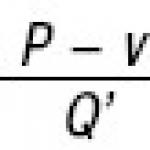Presentation on the topic of obtaining and using nitrogen. Application of nitrogen. Application of nitric acid
Repeat and consolidate knowledge about the structure of the atom and molecule of nitrogen. Study physical and Chemical properties nitrogen. Reveal the role of nitrogen in nature.
“There is no life without nitrogen, for it is an indispensable component of proteins.” D.N. Pryanishnikov
K. Scheele and G. Cavendish obtained nitrogen in 1772. D. Rutherford described the preparation and properties in 1787. Lavoisier proposed the name nitrogen - “lifeless” (and - no, zoe - life). Numerous names: unclean gas, suffocating gas, spoiled air, flammable air, saltpeter, putrefactive agent, deadly gas, nitrogen, etc.
Natural form Earth's shell Ammonium salts and nitric acid Lithosphere, hydrosphere Nitrogen Atmosphere Nitrogen and ammonia from volcanoes Lithosphere Compounds in some types of fuel (oil, coal) Lithosphere Nucleic acids, protein substances Biosphere
2nd period, 5th group, main subgroup Contains 5 electrons on the outer energy level +7)) 2 5 Oxidizing agent N 0 + 3e - N -3 * Make up formulas for compounds of N with Li, Ca, Al. Reducing agent N 0 –1,2,3,4,5e - N +1 ,N +2 ,N +3 ,N +4 ,N +5 * Make up the formulas of the oxides 3 1 2 4
N N N N BOND: -COVALENT NON-POLAR -TRINARY -STRONG MOLECULE: -VERY STABLE -LOW REACTIVITY 1 3 4 2
Gas without color, odor and taste. Poorly soluble in water. Slightly lighter than air, density 1.2506 kg/m3 Tº pl.= -210 º C Tº boil.= -196 º C Does not support respiration and combustion
Oxidizing N 2 0 2N -3 When heated with other metals (Ca, Al, Fe) At room tº only with Li * At high tº, p, kat (Fe, Al, K oxides) with H 2 Reductive N 2 0 2N +2 * At tº electric arc (3000 - 4000 º C) with O 2
Application Production of ammonia and nitric acid. Creation of an inert atmosphere in metallurgy. Production of nitrogen fertilizers. Production explosives. Liquid nitrogen in medicine. Saturation of steel surface to increase strength
Preparation In industry - from liquid air In the laboratory - by decomposition of unstable nitrogen compounds
1 m 2 o 3 l 4 e 5 k 6 u 7 l 8 a Securing new material
Reflection (work in pairs) Name of the topic - one noun Description of the topic - two adjectives Description of the action - two verbs + gerunds (or three verbs) Attitude to the topic - four words The essence of the topic - one word.
Paragraph No. 23, report sheet, exercise 5 work tetra Write a story on the topic: “The Journey of Nitrogen in Nature” Answer the questions: How can you prove experimentally that there is nitrogen in the air? To transport vegetables and fruits over long distances, refrigerators are used, in which liquid NITROGEN is used as a refrigerant. What properties is this based on?


HISTORY OF THE DISCOVERY 1772 K. Scheele and G. Cavendish obtained nitrogen D. Rutherford described the preparation and properties 1787 Lavoisier proposed the name nitrogen - “lifeless” (but no, zoe - life) Numerous names: unclean gas, suffocating gas, septon, spoiled air, disturbed air, saltpeter, putrefactive agent, deadly gas, nitrogen, etc.

Occurrence in nature: 1) in a free state in the atmosphere (78%), 2) in a bound state (see table) Natural form Earth's shell Salts of ammonium and nitric acid Lithosphere, hydrosphere Nitrogen Atmosphere Nitrogen and ammonia of volcanoes Lithosphere Compounds in some types of fuel ( oil, coal) Lithosphere Nucleic acids, protein substances Biosphere


Here is what famous scientists wrote about Nitrogen: F. Engels - “Life is the way of existence of protein bodies on Earth” D. Rutherford - “Suffocating Air” K. Scheele - “Bad Air” A. Lavoisier - “Lifeless Air” D.I. . Pryanishnikov - “There is no life without nitrogen, for it is the most important component of the protein molecule.”


STRUCTURE AND PROPERTIES OF THE ATOM? period, ? group, ? subgroup Contains at the external energy level? electrons +7)) ? ? ? N 0 + 3e - N -3 * Make up formulas for the compounds of N with Li, Ca, Al. ? N 0 –1,2,3,4,5e - N +1,N +2,N +3,N +4,N +5 * Make up the formulas of the oxides

STRUCTURE AND PROPERTIES OF THE ATOM 2nd period, 5th group, main subgroup C contains 5 electrons on the outer energy level +7)) 2 5 Oxidizing agent N 0 + 3e - N -3 * Make up formulas for compounds of N with Li, Ca, Al. Reducing agent N 0 –1,2,3,4,5e - N +1,N +2,N +3,N +4,N +5 * Make up the formulas of the oxides






STRUCTURE OF THE MOLECULE N N N BOND: -COVALENT NON-POLAR -TRINARY -STRONG MOLECULE: -VERY STABLE -LOW REACTIVITY




CHEMICAL PROPERTIES Assignment: give a complete description of the reactions *; under what conditions (c, t, p) the equilibrium will shift to the right. Oxidizing N 2 0 2N -3 When heated with other metals (Ca, Al, Fe) At room tº only with Li * At high tº, p, kat (Fe, Al, K oxides) with H 2 Reductive N 2 0 2N +2 * At tº electric arc (ºС) with O 2

TEST YOURSELF N 2 +3H 2 2NH 3 +Q Reversible Compounds Exothermic Homogeneous Catalytic with N 2 and H 2 increase tº decrease p increase N 2 +O 2 2NO –Q Reversible Compounds Endothermic Homogeneous Non-catalytic with N 2 and O 2 increase tº increase p does not affect

Questions for self-control 1. Gas without color, taste and smell 2. The molecule is diatomic 3. Content in the air is 78% 4. In the laboratory it is obtained by the decomposition of KMnO 4 and H 2 O 2 5. In industry - from liquid air 6. Chemically inactive 7. Interacts with almost all simple substances 8. The processes of respiration and photosynthesis are associated with it 9. Is an integral part of proteins 10. Participates in the cycle of substances in nature

TEST YOURSELF O 2 1, 2, 4, 5, 7, 8, 10. “5” N 2 1, 2, 3, 5, 6, 9, 10. “5” 1-2 errors “4” 3-4 errors “3” 5 errors or more “2” Using information about nitrogen as an example, give arguments in favor of two points of view: 1. Nitrogen is “lifeless” 2. Nitrogen is the main element of life on Earth.


Application of nitrogen
Pure nitrogen is used in various production processes, including ammonia synthesis and production of nitrogen fertilizers, methane conversion, processing of associated gases.
Nitrogen is used to protect ferrous and non-ferrous metals during annealing. It finds applications in the processes of neutral hardening, stress-relieving annealing, carburization, cyanidation, soldering brazing, powder metal sintering, extrusion die cooling. Metallurgy
The use of nitrogen when treating paper, cardboard and even wood objects with ultraviolet or cathode rays to polymerize the varnish coating allows for reduced photoinitiator costs, reduced VOC emissions, improved processing quality, etc. Pulp and paper industry
IN Food Industry nitrogen is registered as a food additive E941, as a gaseous medium for packaging and storage, a refrigerant, and liquid nitrogen is used when bottling oils and non-carbonated drinks to create excess pressure and an inert environment in soft containers Food industry
Nitrogen is used in oil and gas production to maintain in-situ pressure and increase product production. This inert gas is widely used to create an inert cushion to ensure explosion and fire safety in process tanks, as well as during loading and unloading operations. Nitrogen is used to maintain a certain pressure in oil and gas tanks, to clean process tanks on gas carriers and LNG and LNG storage facilities, and to purge pipelines. Oil and gas industry
Nitrogen is used for tank protection, raw material and product storage, chemical transport and packaging. medicines. Pharmaceuticals
Preventing oxidation in semiconductor and electrical circuit manufacturing, purging and cleaning are the main applications of nitrogen in the electronics industry. Electronics
Nitrogen is used in this industry to cool the electrodes of arc furnaces. In addition, it is used to protect against oxidation during production and reduce air temperature. Glass industry
Liquid nitrogen is widely used as a refrigerant; it is used in medicine, especially in cosmetology. Medicine
Nitrogen is the most popular gas for ensuring explosion and fire safety in various industries: from food to nuclear. Being an inert gas, nitrogen allows, when supplied to a technological volume, to displace oxygen and avoid an oxidation reaction. Firefighting
To use presentation previews, create a Google account and log in to it: https://accounts.google.com
Slide captions:
Daniel Rutherford The Story of a Discovery Joseph Priestley Lavoisier, Antoine Laurent Henry Cavendish
7)) +82)))))) +51))))) +33)))) +15))) 5e- 5e- 5e- 5e- 5e-
N2 molecular formula N N electronic formula structural formula
nitrogen - a simple substance, V, C, Z, M N2 Boil = - 195 C Melt = - 210 C 0 0
obtaining in a laboratory in industry
N2 Liquid nitrogen in medicine Ammonia synthesis Fertilizer production Nitric acid synthesis Creation of an inert environment
Test A1. The sum of protons, neutrons, electrons in an atom 14 N 1) 7 2) 14 3) 28 4) 21 A2. Chemical elements are arranged in increasing order of their atomic radii 1) N, C, B 3) N, O, F 2) N, P, As 4) B, Si, N 4) 21 2) N, P, As
A3. Chemical bond in a nitrogen molecule 1) ionic 2) polar covalent 3) nonpolar covalent 4) hydrogen A4. The highest degree of nitrogen oxidation in the compound 1) HNO 3 2) NO 2 3) NO 4) HNO 2
A5. The sum of the coefficients in the reaction equation between nitrogen and hydrogen is 1) 2 2) 3 4) 5 4) 6 A6. The decomposition reaction includes 1) N 2 + 3H 2 = 2NH 3 2) N 2 + O 2 = 2NO 3) 6Li + N 2 = 2Li 3 N 4) NH 4 NO 2 = N 2 + 2H 2 O 4) 6 4 ) NH 4 NO 2 = N 2 + 2H 2 O
A7. Nitrogen is a reducing agent in the reaction 1) N 2 + 3H 2 = 2NH3 2) N 2 + O 2 = 2NO 3) 6Li + N 2 = 2Li 3 N 4) N 2 + 3Ca = Ca 3 N 2
Full name: Shitikova Svetlana Evgenievna Presentation on the topic: “Nitrogen and its properties.” Subject: chemistry. Position: teacher. Name of educational institution: Municipal educational institution Sosnovskaya average comprehensive school № 2






